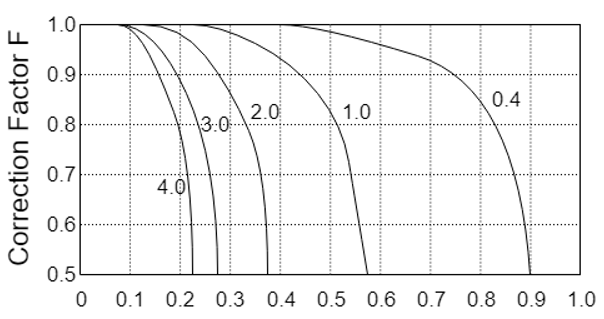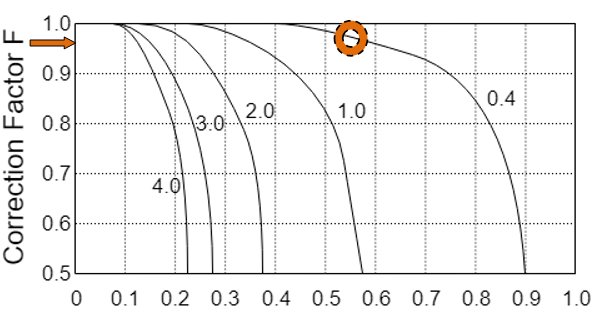This set of Heat Transfer Operations Interview Questions and Answers for freshers focuses on “Shell and Tube Heat Exchangers – Log-Mean Temperature Difference and Correction Factor”.
1. When using ΔTLM for a shell and tube heat exchanger, we cannot use the conventional formula for LMTD.
a) True
b) False
View Answer
Explanation: In a shell and tube heat exchanger we observe both counter current and concurrent flow at different regions of the shell.
2. What should be the minimum value of the Correction Factor to get multiplied to LMTD?
a) >1
b) <2
c) <1
d) >2
View Answer
Explanation: The value of corrected LMTD should be less than the theoretical LMTD considering countercurrent flow. Thus the LMTD correction factor is less than 1.
3. Which of the following has the Log mean temperature difference is used for corrected LMTD for a Shell and tube Heat Exchanger?
a) Counter-flow
b) Parallel Flow
c) Cross Flow
d) Split Flow
View Answer
Explanation: The mean temperature difference for a counter-flow operation is uniform throughout the length of the tube and hence gives the maximum value to the LMTD. Thus as Ft < 1, we get correct LMTD from this.
4. What should be the minimum value of LMTD Correction Factor F for steady state operation of the equipment?
a) <0.5
b) <1
c) 1 > F > 0.75
d) 1 > F > 0.5
View Answer
Explanation: The value of corrected LMTD should be less than the theoretical LMTD considering countercurrent flow. Thus the LMTD correction factor is less than 1. Also for steady state operation of the HE, its value should be more than 0.75.
5. Why do we use LMTD Correction factor?
a) Incomplete Countercurrent flow
b) Leakage leading to heat loss
c) Counter current and Co-current at parts
d) Due to fouling
View Answer
Explanation: In a shell and tube heat exchanger we observe both counter current and concurrent flow at different regions of the shell. This phenomenon makes the use of complete countercurrent LMTD unsuitable for calculations.
6. What is the value of Correction Factor?
Find the value from the below F-curve chart where R = 2, P = 0.3.

a) 0.86
b) 0.90
c) 0.80
d) 0.82
View Answer
Explanation: For the estimation of F value from the given graph, we 1st freeze the curve of value R = 2, then we go vertically up from the point P = 0.3 to cut the curve R = 2, hence the point of intersection’s y-axis value give the value of F.
7. The value of correction factor can be equal to 1 in most cases of operation.
a) True
b) False
View Answer
Explanation: In a shell and tube heat exchanger for most industrial purposes, it never achieves complete counter current flow regime for which the value of F is always < 1.
8. In a shell and tube heat exchanger, in the inner side fluid enters at 15℃ and leaves at 65℃. The shell has steam at 1atm. What is the value of corrected LMTD and correction factor?
a) 39℃, F = 0
b) 56.35℃, F = 0
c) 70℃, F = 1
d) 56.35℃, F = 1
View Answer
Explanation: As steam is condensing at 100℃ (Tvap at 1atm) hence we have T1=T2, thus R = 0 and F = 1; we have
LMTD = \(\frac{(TH1-TC2)-(TH2-TC1)}{Ln(\frac{TH1-TC2}{TH2-TC1})}\)
LMTD = \(\frac{(100-15)-(100-65)}{Ln(\frac{100-15}{100-65})}\) = 56.35℃.
9. Which one of the following are correct relation of R and P?
(T/t =shell/tube, 1⁄2 = inlet/outlet)
a) R = \(\frac{T_2-T_1}{t_2-t_1}\), P = \(\frac{t_2-t_1}{T_2-T_2}\)
b) R = \(\frac{T_2-T_1}{t_2- t_1}\), P = \(\frac{t_2- t_1}{T_1- t_1}\)
c) R = \(\frac{T_2-T_1}{t_2- t_1}\), P = \(\frac{t_2- t_1}{T_2- T_1}\)
d) R = \(\frac{T_1-T_2}{t_2- t_1}\), P = \(\frac{t_2- t_1}{T_1- t_1}\)
View Answer
Explanation: R and P are temperature factors which are required to calculate the Correction factor from the F-curve chart. The correct formula for them is R = \(\frac{T_1-T_2}{t_2- t_1}\), P = \(\frac{t_2- t_1}{T_1- t_1}\).
10. In a shell and tube heat exchanger, in the inner side fluid enters at 15℃ and leaves at 65℃. The shell has oil entering at 105℃ and leaving at 85℃. What is the value of correction factor coefficients R and P?
a) R = 0.4, P = 0.55
b) R = 0.3, P = 0.55
c) R = 0.4, P = 0.66
d) R = 0.3, P = 0.66
View Answer
Explanation: R and P are temperature factors which are required to calculate the Correction factor from the F-curve chart. The correct formula for them is R = \(\frac{T_1-T_2}{t_2- t_1}\), P = \(\frac{t_2- t_1}{T_1- t_1}\) hence putting the values we get R = \(\frac{105-85}{65-15}\) = 0.4 and P = \(\frac{65 – 15}{105-15}\) = 0.55.
11. In a shell and tube heat exchanger, in the inner side fluid enters at 15℃ and leaves at 65℃. The shell has oil entering at 105℃ and leaving at 85℃. What is the value of correction factor F?

a) 0.94
b) 0.96
c) 0.99
d) 0.91
View Answer
Explanation: R and P are temperature factors which are required to calculate the Correction factor from the F-curve chart. The correct formula for them is R = \(\frac{T_1-T_2}{t_2- t_1}\), P = \(\frac{t_2- t_1}{T_1- t_1}\) hence putting the values we get R = \(\frac{105-85}{65-15}\) = 0.4 and P =\(\frac{65 – 15}{105-15}\) = 0.55 and for this value of R and P we can determine our F from the F-curve. For the estimation of F value from the given graph, we 1st freeze the curve of value R = 0.4, then we go vertically up from the point P = 0.55 to cut the curve R =0.4, hence the point of intersection’s y-axis value give the value of F which is very close to 0.94.

12. What are the axes of the F-curve?
a) X – Correction Factor, Y – R
b) X – Correction Factor, Y – mean of P and R
c) Y – Correction Factor, X – R
d) Y – Correction Factor, X – P
View Answer
Explanation: The F curve is a plot between the correction factor F and the coefficient P with different concave downward curves for different values of R ranging anywhere between the 0.2 to 5.
13. If we are given F value and R value, which is the only one variable we cannot determine by this information?
a) Value of P
b) Temperature of inlet and outlet of shell
c) Temperature of inlet and outlet of tube
d) Temperature of inlet and outlet of shell and tube
View Answer
Explanation: Given R and F we can find P easily from F-curve, then we will be having 2 equations hence we can have maximum two variable to be able to do the calculations, hence, the incorrect option is temperature of inlet and outlet of shell and tube which has 4 variables which cannot be determined.
Sanfoundry Global Education & Learning Series – Heat Transfer Operations.
To practice all areas of Heat Transfer Operations for Interviews, here is complete set of 1000+ Multiple Choice Questions and Answers.
If you find a mistake in question / option / answer, kindly take a screenshot and email to [email protected]
- Apply for Chemical Engineering Internship
- Practice Chemical Engineering MCQs
- Check Chemical Engineering Books
- Check Heat Transfer Operations Books
